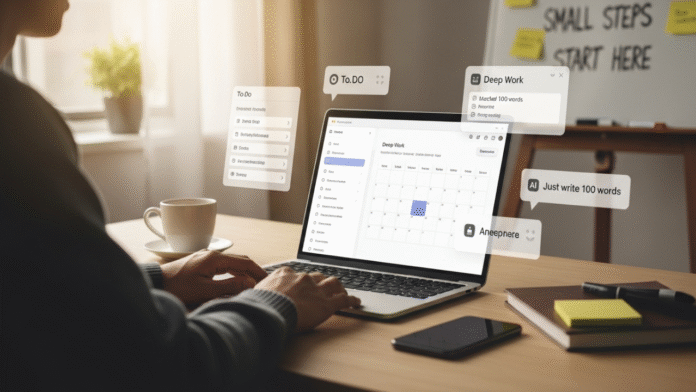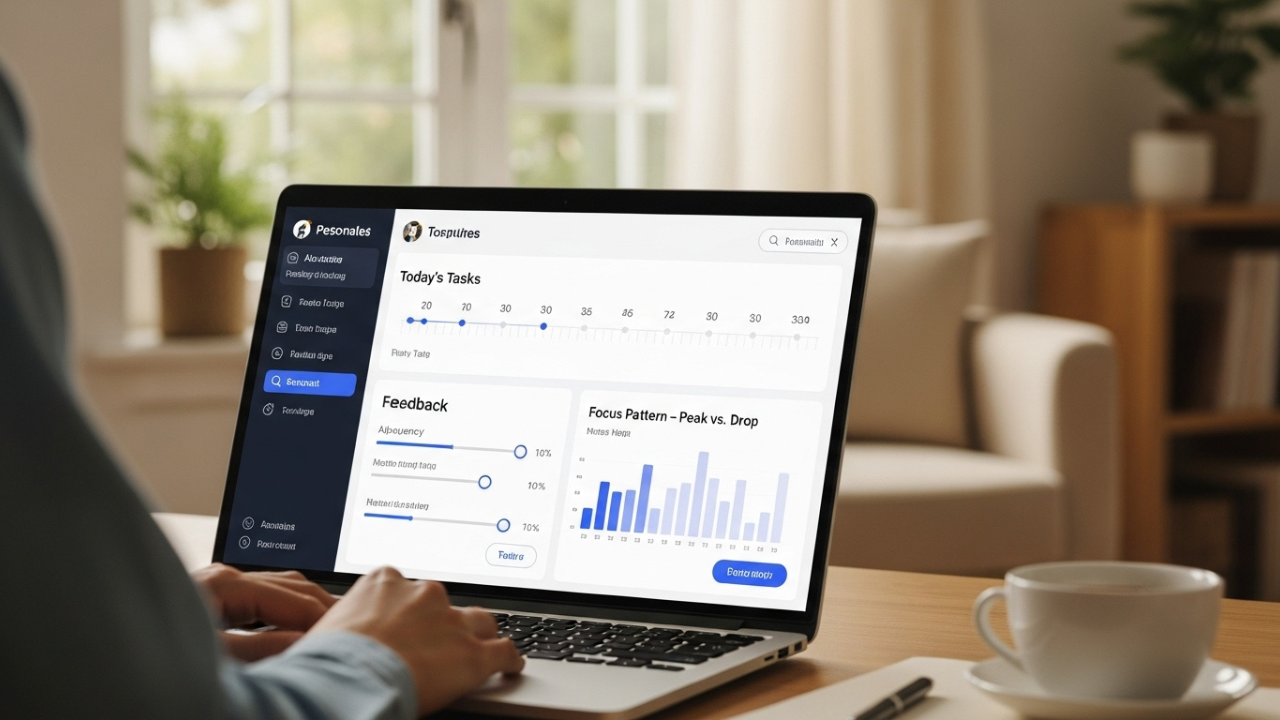An Anti-Procrastination Workflow: 3 AI Tools That Force You to Be Productive
Laziness does not mean procrastination. You know it, too, when you are procrastinating today and have some crucial duty to accomplish, but instead, you get engaged in some sort of much minor activity, such as reorganizing the files or watching the same video you had already watched several times. The clock ticks. You say, “I’ll start in 10 minutes.” An hour passes. The task still waits.
You’re not broken. You’re human.
The thing is that the procrastination process is not the issue of character rather than a mechanism of coping. It likes to pretend it is overwhelmed, or perfectionist, or mentally tired, or not know where to start.
Now, something is quietly changing the game — and it’s not another productivity app. It’s AI.
Unlike traditional tools that expect you to have motivation and clarity before you start, AI tools for productivity can help you start even when you feel stuck. They work with your habits, your rhythms, your resistance — and gently nudge you forward.
It is your handbook about how AI can help you to stop procrastinating and finally take action.
What Is Procrastination, Really?
Never mind the stereotype. Procrastination is not an issue of laziness and carelessness. Most of the time it is the consequences of:
Unclear priorities
Mental fatigue
Fear of failure
Avoidance of discomfor
Lack of structure
You might be interested in getting things done. However, when your task is more intimidating than you feel capable of handling, that is, when it is too large or too amorphous, or is otherwise emotionally burdensome, then your brain moves over to more physically undemanding and more pleasurable activities such as checking your phone or straightening your desktop. You have an illusion of getting more things done but in reality you are not.
To break this cycle, you don’t need tougher discipline. You need a better system — one that can help you think clearly, stay focused, and reduce the number of choices you have to make.
Why AI Might Be the Most Helpful Tool You’ve Never Tried
Most people think of AI as something far removed — used in tech labs or for complex tasks. But in everyday life, AI is becoming your silent productivity partner.
Where traditional tools offer checklists and timers, AI offers something more powerful:
Task breakdown
Smart scheduling
Focus assistance
Pattern recognition
Emotional nudges
It doesn’t just remind you to work. It helps you figure out how to work, when to work, and why a task might be getting ignored.
It can take a giant, vague task — like “Write project proposal” — and break it into steps: brainstorm, outline, draft, edit. It can schedule those parts into your day, based on how and when you work best.
The Four Faces of Procrastination — And How AI Helps
Everyone procrastinates differently. You might recognise yourself in one of these patterns — or in all of them, depending on the day.
Pattern 1 — You Avoid Big, Vague Tasks
You look at a task like “Build website” or “Write research paper” and freeze. It’s too big. Where do you start?
AI Solution: Tools like Motion or Taskade AI take a big goal and break it down. Not once, but repeatedly, at your schedule. You do not have to look at the giant task you are going to complete, but at the action you would take now: “Write 100 words” or “Choose color theme.”
All of a sudde,n the job seems doable. And possibly leads to progress.
Pattern 2 — You Get Sucked Into Mindless Scrolling
You sit down to start, open a browser tab, and somehow lose 40 minutes to unrelated searches, chats, or videos.
AI Solution: Reclaim AI syncs with your calendar and locks in protected focus blocks. Paired with Freedom, a tool that blocks distracting sites during scheduled sessions, it becomes nearly impossible to wander. Even if your hands want to open YouTube, your environment won’t let you.
It’s not about willpower. It’s about removing the temptation.
Pattern 3 — You Wait for the Right Mood
You say to yourself, I do not feel like writing. Or, I will do it when I get more motivated.
AI Solution: Mood-aware tools like Mindsera or Reflectly help you log your emotional state and offer small nudges. They don’t ask you to leap. They request small actions that seem achievable.
In case you type the following, I feel overwhelmed. AI can answer the following: Would you like to name only 3 things that you can do today? The task shrinks. The barrier lowers. The guilt fades.
Pattern 4 — You Multitask Yourself Into Burnout
You juggle 10 tabs, answer messages mid-task, and constantly switch focus. By the end of the day, nothing is fully done.
AI Solution: Akiflow and Notion AI help centralise everything — tasks, notes, reminders, goals — into one streamlined dashboard. They detect patterns and guide you to batch similar tasks together, reducing mental friction.
Less chaos means less exhaustion — and more meaningful progress.
Choosing the Right AI Tool Based on Your Challenge
AI isn’t one-size-fits-all. The right tool depends on your pattern of procrastination. Here’s a quick reference table:
Google Snippet Format – AI Tools Matched to Problems
| Problem You Face | Recommended AI Tool | What It Helps With |
| Big tasks feel overwhelming | Motion, Taskade AI | Breaks tasks down, auto-schedules steps |
| Constant digital distractions | Reclaim + Freedom | Creates focus windows, blocks distracting apps |
| Waiting to feel motivated | Mindsera, Reflectly | Mood tracking, reflective nudges |
| Scattered tools and workflows | Akiflow, Notion AI | Unifies tasks, notes, and calendars in one place |
Try one tool at a time. Start small. You’re not rebuilding your habits overnight — you’re layering in smart support.
Step-by-Step: How to Use AI to Actually Get Started
So let’s say you’ve picked a tool. Now what? Here’s a basic workflow for using AI to break the cycle of delay:
Step 1 — Define Your Task Clearly
Vague = delay. Before using the tool, define what you need to do in specific terms. Instead of “Work on client project,” write “Draft introduction slide.”
Step 2 — Let the AI Break It Down
Feed that task into your AI tool. Let it divide it into micro-steps, or suggest time slots that work with your calendar.
Step 3 — Block Time and Eliminate Options
Use a scheduling AI to assign the task to a real time in your day. Combine with tools that block distractions during that time.
Step 4 — Take the First Tiny Step
Just follow the first prompt. That’s it. Not the whole project. Not the full deliverable. Just what’s on today’s plate?
Step 5 — Check In, Adjust, Repeat
Spare one minute at the end of your session with some reflection. Was it effective? Was the step too small, too big, or too boring? Let the AI learn with you — and tweak the next day’s plan.
Real-Life Stories of Beating Procrastination With AI
These aren’t extreme productivity gurus. These are everyday people like you, using AI to shift from “I’ll do it later” to “I’ve already started.”
The Student Who Used Motion to Finish Essays Without Panic
Sofia is a university student who was always paralysed by essays. She would be sitting in front of her laptop and looking at an empty doc , and would become tired all of a sudden. Even though she loved her subject, deadlines became dread.
She started using Motion, an AI scheduler. The tool took her tasks — “Draft intro,” “Find citations,” “Write conclusion” — and slotted them into her calendar. It didn’t just list them; it decided when she should do each, based on her availability.
The result? Sofia didn’t feel responsible for making decisions. She just followed the plan. Bit by bit, the paper got written — and her anxiety dropped.
The Freelancer Who Got Her Mornings Back Using Reclaim
Carla, a freelance copywriter, found herself wasting hours every morning checking email and bouncing between small tasks. By the time she got to the real work, her energy was gone.
She integrated Reclaim, which locked “deep work” blocks into her calendar each morning. Combined with Freedom, it blocked sites like Gmail and Twitter during those windows.
In two weeks, Carla’s productivity doubled — without waking up earlier or working more. She simply stopped losing the first two hours of her day.
Tips to Make AI Work for Your Brain, Not Against It
AI is smart — but you’re still in charge. Here’s how to use it in a way that fits your natural patterns, not someone else’s idea of productivity.
Start With a Single Use Case
Don’t try to rebuild your life in a day. In case you postpone the writing process every time, begin with a single tool that will assist you only with writing. Then, when it is comfortable, add more.
Adjust Frequency, Not Just Deadlines
If a tool schedules tasks too often, it can feel overwhelming. Most AI schedulers let you change your workload — fewer tasks per day, longer sessions, or more break time. Make the tool reflect your energy, not just the clock.
Use the Feedback Loop
Many tools — like Rize or Motion — track how you use your time. That’s not just data. It’s insight. If you’re always breaking focus at 2 PM, try switching to easier tasks then. AI is smart, but it gets smarter when you listen to your own patterns, too.
My Opinion| AI as a Quiet Partner, Not a Savior
There is one thing to remember after reading this guide, and it is the following:
The last thing to battle with is procrastination. It’s something to understand.
AI doesn’t shame you. It doesn’t care if you missed three deadlines or haven’t opened your project in a week. It just offers you a way forward — quietly, consistently, and without judgment.
You don’t need to be perfect. You don’t need to overhaul your life. You just need one tiny step. Then another. And another.
Let AI tools give you the map — but remember, you’re still the one taking the steps.



